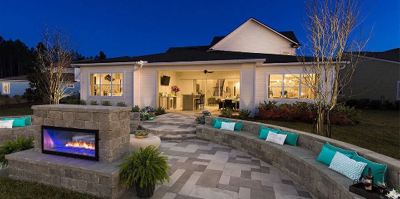Want a backyard that looks great and actually works for how you live? A custom paver patio can do both. Whether you want a space to relax, grill, or hang out with friends, pavers are a smart, long-lasting choice. They handle the elements, stay cooler in the sun, and give your outdoor space a clean, finished look.
Let’s walk through why more homeowners are choosing paver patios for lasting beauty and function.

Why Choose Pavers Over Concrete or Wood?
Concrete cracks. Wood rots. Pavers don’t.
Here’s why pavers are worth it:
They hold up well in heat, rain, and cold
You can replace one piece if needed
They’re slip-resistant and safer
They boost home value with better design
Luxury Patio Design Ideas That Fit Your Home
No two yards are the same—your patio shouldn’t be either. Pavers give you options.
Earth-tones blend with most landscapes
Curved layouts feel more natural
Contrasting borders add detail
Match your walkway or driveway for a seamless look
What Happens During Patio Installation?
The key to a long-lasting patio is the foundation. A solid install usually looks like this:
Remove any grass or old materials
Level and compact a gravel base
Lay pavers in your chosen pattern
Fill gaps with sand
Compact the full surface for a firm finish
Done right, this prevents sinking, puddles, or cracks..
How Much Do Paver Patios Cost?
Pavers cost more upfront than concrete, but they last longer and need fewer repairs. That saves money over time.
The average cost is $10 to $20 per square foot
Prices vary based on size and design
Longer life means fewer replacements
Adds value to your home if you plan to sell
Why Professional Experience Matters
Paver patios aren’t one-size-fits-all. Soil, weather, and drainage vary by region, so experience matters.
Skilled crews know how to prep for shifting soil
They follow local building codes and HOA rules
They help you choose the right material for your climate
Keeping Your Paver Patio in Great Shape
Low maintenance, high reward. Just keep it clean and sealed.
Sweep regularly to avoid stains and moss
Rinse after heavy weather
Refill the joint sand every few years
Seal for extra protection against food, oil, or rust
With basic upkeep, your patio can stay sharp for over a decade.
Easy Add-Ons That Make a Big Impact
Want to level it up? Try adding:
A fire pit for cozy nights
A pergola or shade cover
An outdoor kitchen setup
Pathway lighting or garden edging
Like your luxury paver patio, a quality concrete driveway should be built to last and boost the look and feel of your outdoor space.
Eco-Friendly Outdoor Options
Modern paver patios aren’t just good-looking—they’re smart for the environment too.
Permeable pavers help water soak into the ground
Light-colored pavers reflect the sun and stay cooler
Individual replacements mean less waste long term
What Is the Cost of Concrete Compared to Pavers?
Concrete patios: $6–$12 per square foot
Paver patios: $10–$20 per square foot
While concrete is cheaper up front, pavers win long term. They crack less, look better, and don’t need as much repair.
Ready to Build Your Backyard Patio?
A luxury paver patio is more than a home upgrade—it’s an investment in how you live outside. It looks great, lasts for years, and makes your outdoor space more usable and enjoyable every season.


(0) comments
We welcome your comments
Log In
Post a comment as Guest
Keep it Clean. Please avoid obscene, vulgar, lewd, racist or sexually-oriented language.
PLEASE TURN OFF YOUR CAPS LOCK.
Don't Threaten. Threats of harming another person will not be tolerated.
Be Truthful. Don't knowingly lie about anyone or anything.
Be Nice. No racism, sexism or any sort of -ism that is degrading to another person.
Be Proactive. Use the 'Report' link on each comment to let us know of abusive posts.
Share with Us. We'd love to hear eyewitness accounts, the history behind an article.